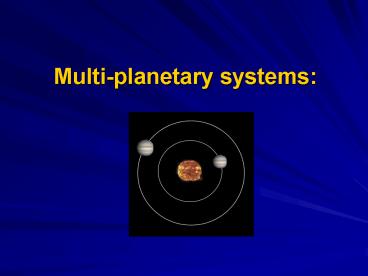Multi-planetary systems: - PowerPoint PPT Presentation
1 / 45
Title:
Multi-planetary systems:
Description:
(S.Ferraz-Mello, 2005) Class Ia Planets in mean motion resonance. Class Ib Low-eccentricity near ... the alignment and anti-alignment for the apsidal lines. ... – PowerPoint PPT presentation
Number of Views:33
Avg rating:3.0/5.0
Title: Multi-planetary systems:
1
Multi-planetary systems
2
- Multi-planetary systems
- Binaries
- Single Star and Single Planetary Systems
3
Classification of the known multi-planet systems
(S.Ferraz-Mello, 2005)
- Class Ia gt Planets in mean motion resonance
- Class Ib ? Low-eccentricity near-resonant planet
- pairs
- Class II? Non-resonant planets with significant
- secular dynamics
- Class III? Hierarchical planet pairs
4
Class Ia -- Planets in mean-motion resonance
This class contains planet pairs with large
masses and eccentric orbits that are relatively
close to each other, where strong gravitational
interactions occur. Such systems remain stable
if the two planets are in mean motion resonance
(MMR).
5
Star Planet mass_P a_P
e_P Period M_Sun M_Jup
AU days GJ 876 b
0.597 0.13 0.218 30.38
(0.32) c 1.90 0.21
0.029 60.93 55 Cnc b
0.784 0.115 0.02 14.67 (1.03)
c 0.217 0.24 0.44
43.93 HD82942 b 1.7
0.75 0.39 219.5 (1.15) c
1.8 1.18 0.15 436.2
HD202206 b 17.5 0.83
0.433 256.2 (1.15) c
2.41 2.44 0.284 1296.8
6
Class 1b -- Low-eccentricity near-resonant planet
pairs A mean motion resonance of the planet pair
is not needed to guarantee the long-term
stability of the system. Therefore, the
eccentricities of the planets have to be small
to exclude a crossing of the orbits. As an
example we state the 47Uma system, which is
possibly near the 52 or 73 MMR but the orbital
parameters show that a resonance is not needed
for the stability of the system. Star
Planet mass_P a_P e_P
Period M_Sun M_Jup
AU days 47Uma
b 2.9 2.1 0.05
1079.2 (1.03) c
1.1 4.0 0.0 2845.0
7
Unstable orbits 21 1.3 AU 31 1 AU SR 0.8
0.9 AU 41 0.82 AU Stable orbits Between
resonances
habitable zone
Terrestrial planet is possible!
8
Class II -- Non-resonant planets with significant
secular dynamics Planet
pairs of this class can have strong gravitational
interactions, where long-term variations are
ascribed to secular perturbations, large
variations of the eccentricities and dynamical
effects like the alignment and anti-alignment
for the apsidal lines. For the long-term
stability of such a system, it is not necessary
hat the planets are in MMR.
9
- Star Planet mass_P a_P
e_P Period - M_Sun M_Jup
AU days - 55 Cnc e 0.045 0.038
0.17 2.808 - (1.03) b 0.784 0.115
0.02 14.67 - HD169830 b 2.88 0.81
0.31 225.62 - (1.4) c 4.04
3.6 0.33 2102 - HD37124 b 0.72 0.54
0.1 153 - (0.91) c ? 1.3 2.5
0.7 1595 - (Ups And, HD12661, HD160691)
10
Class III -- Hierarchical planet pairs Roughly
speaking this class is for all planet pairs with
a large ratio of their orbital periods -- P1/P2
gt 10. Due to the large ratio of periods the
gravitational interaction are not so strong like
in class II and the probability of a capture in
a MMR is negligible. The weaker interactions
lead to stable motion in the numerical
simulations, even if the orbits of the planet are
not so good determined.
11
Star Planet mass_P a_P e_P
Period M_Sun M_Jup
AU
days HD168443 b 7.7
0.29 0.529 58.116 (1.01)
c 16.9 2.85 0.228
1739.5 HD74156 c 1.86
0.294 0.636 51.643 (1.27)
b 6.17 3.40 0.583
2025.0 HD38529 b 0.78
0.129 0.29 14.309 (1.39)
c 12.7 3.68
0.36 2174.3
12
Class 1b -- Low-eccentricity near-resonant planet
pairs A mean motion resonance of the planet pair
is not needed to guarantee the long-term
stability of the system. Therefore, the
eccentricities of the planets have to be small
to exclude a crossing of the orbits.
13
Motivation
- A study of
- Extra-solar planetary systems
- similar to
- our solar system
14
Initial Conditions and Computations
- Jupiter on its orbit
- Saturn a_sat 8 ..... 11 AU
- m_sat 1 .... 30xm_Sat
- Testplanets in the HZ
- a_tp 0.6 ..... 1.6 AU
Mercury 6 (J. Chambers) Integration time
20 mio years HZ maximum ecc.
15
(No Transcript)
16
HZ im Sonnensystem
- Kasting 0.93 1.3 AU
- Mischna 0.93 1.7 AU
- Forget 0.93 2 AU
- alt 0.93 AU ? H2O becomes a major atmospheric
compound and is rapidly lost to space after UV
photolysis - agt1.3 AU ? CO2 condensates in the atmosphere
producing CO2-clouds, that can affect
significantly the T-CO2 coupling
17
Sun Jupiter Saturn
18
(No Transcript)
19
(No Transcript)
20
Sun Jupiter Saturn
21
Influence of a third giant planet
Jupiter Saturn -Uranus
Jupiter -- Saturn
22
(No Transcript)
23
(No Transcript)
24
(No Transcript)
25
Influence of a third giant planet
Jupiter Saturn -Uranus
Jupiter -- Saturn
26
(No Transcript)
27
(No Transcript)
28
(No Transcript)
29
(No Transcript)
30
Sun-Jupiter-Saturn-Uranus
Influence on an Earth-like planet at 1 AU
31
Earth-like planets in inclined multi-planetary
systems similar to the Solar system
32
Motivation
- The discovery of
- the planetary system
- OGLE
06-109l
33
Initial Conditions and Computations
- Jupiter on its orbit
- Saturn a_sat 8 ..... 11 AU
- i_sat 10 .... 60 deg
- Testplanets in the HZ
- a_tp 0.6 ..... 1.6 AU
Mercury 6 (J. Chambers) Integration time
20 mio years HZ maximum ecc.
34
Sun Jupiter Saturn
35
Increase of iSaturn 10 deg
36
Orbits of Venus, Earth and Mars
37
iSaturn 20deg
Escape of Saturn for a_Sat 8.2 AU
38
(No Transcript)
39
iSaturn 30deg
40
(No Transcript)
41
iSaturn 40 deg
42
(No Transcript)
43
iSaturn 50 deg
44
(No Transcript)
45
Conclusion
- The inclination of Saturn influences the inner
Solar system - For small i -- the two planets in MMR
- High i -- may lead to escapes of Saturn
- For i gt 60 all systems are unstable































